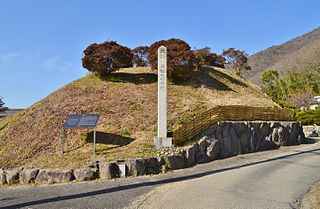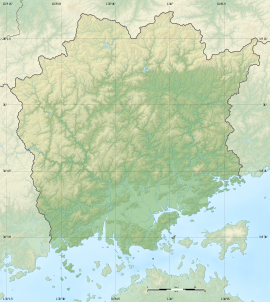
Kofun are megalithic tombs or tumuli in Northeast Asia. Kofun were mainly constructed in the Japanese archipelago between the middle of the 3rd century to the early 7th century CE.

Kurashiki is a city located in Okayama Prefecture, Japan. As of 31 March 2023, the city had an estimated population of 478,651 and a population density of 1300 persons per km². The total area of the city is 355.63 square kilometres (137.31 sq mi).
Ōzuka-Senbōyama Sites (王塚・千坊山遺跡群) is a group of seven archaeological sites located in what is now part of the city of Toyama in the Hokuriku region of Japan. The sites consist of the ruins of a settlement which existed from the late Jōmon period through Kofun period, and several necropolis with numerous kofun burial mounds. The Ōzuka Kofun received protection as a National Historic Site in 1948 and the area under protection was expanded to cover the other six sites in 2005.
The Shinpōinyama Kofun group is cluster of kofun burial mounds dating from the late Yayoi to the early Kofun period located in the Mukasatakenouchi neighborhood of the city of Iwata, Shizuoka in the Tōkai region of Japan. The site was designated a National Historic Site of Japan in 1987.

The Kōjinyama Kofun (荒神山古墳) is a Kofun period burial mound located between the Hinatsu and Kiyosaki neighborhoods of the city of Hikone Shiga Prefecture in the Kansai region of Japan. The tumulus was designated a National Historic Site of Japan in 2011.

The Hashihaka kofun is a megalithic tomb (kofun) located in Sakurai, Nara Prefecture, Japan. The Hashihaka kofun is considered to be the first large keyhole-shaped kofun constructed in Japan and is associated with the emergence of the Yamato Kingship.

The Makimuku ruins are ruins in Nara Prefecture Sakurai near Mount Miwa of the Yayoi Period.

The Okameishi Kofun (お亀石古墳) is a Kofun period square-shaped burial mound, located in the Nakano neighborhood of the city of Tondabayashi, Osaka in the Kansai region of Japan. The tumulus was designated a National Historic Site of Japan in 2002 collectively with the nearby Shindō temple ruins and the Oganji-ike tile kiln ruins.
The Hiyoshigaoka - Akashi Tumuli is a group of late Yayoi to early Kofun period burial mounds, located in the Akeshi neighborhood of the town of Yosano, Kyoto in the Kansai region of Japan. The tumulus group was designated a National Historic Site of Japan in 2005.

The Yoshima Kofun (吉島古墳), also known as the Yoshima Matsuyama Kofun (吉島松山古墳) is a kofun burial mound located in the Shingū neighborhood of the city of Tatsuno, Hyōgo Prefecture, in the Kansai region of Japan. The tumulus was designated a National Historic Site in 1978.

The Tano Site is an archaeological site with the traces of a Yayoi period settlement straddling the border between the cities of Amagasaki and Itami, Hyōgo Prefecture, in the Kansai region of Japan. It was designated a National Historic Site in 1969.
The Amidaji Kofun cluster (阿弥大寺古墳群) is a group of three late Yayoi period burial mounds located in the Shimofukuda neighborhood of the city of Kurayoshi, Tottori Prefecture in the San'in region of Japan. The tumulus group was designated a National Historic Site of Japan in 1981.

The Ōya-Sada Kofun Cluster is a group of six kofun burial mounds located in the Kaminakatsui neighborhood of the city of Maniwa, Okayama Prefecture, in the San'yō region of Japan. The tumuli were collectively designated a National Historic Site in 2008. The tumuli area considered to be representative of large chieftain tombs of the late Kofun period of the Kingdom of Kibi.

Ryōgūzan Kofun (両宮山古墳) is a Kofun period burial mound, located in the city of Awaiwa, Okayama Prefecture, in the San'in region of Japan. The tumulus was designated a National Historic Site of Japan in 1924 with the area under protection expanded in 1978 and again in 2006. It is largest keyhole-shaped burial mound in the Bizen region and the third largest in Okayama Prefecture, and the 39th largest in Japan.

Urama Chasusuyama Kofun (浦間茶臼山古墳) is a Kofun period burial mound located in the Urama neighborhood of Higashi-ku, Okayama, Okayama Prefecture, in the San'yō region of Japan. The tumulus was designated a National Historic Site of Japan in 1974.It is believed to have been built at the end of the 3rd century in the early Kofun period. It is one of the oldest large keyhole-shaped burial mounds in ancient Kingdom of Kibi.
Tsuruyama Maruyama Kofun (鶴山丸山古墳) is a Kofun period burial mound, located in the Hatakeda, neighborhood of the city of Bizen, Okayama Prefecture, in the San'yō region of Japan. The tumulus was designated a National Historic Site of Japan in 1957.

Musa Ōtsuka Kofun (牟佐大塚古墳) is a Kofun period burial mound located in the Musa neighborhood of Kita-ku, Okayama, Okayama Prefecture, in the San'yō region of Japan. The tumulus was designated a National Historic Site of Japan in 1930.

Onoe Kurumayama Kofun (尾上車山古墳) is a Kofun period burial mound located in the Onoe neighborhood of Kita-ku, Okayama, Okayama Prefecture, in the San'yō region of Japan. The tumulus was designated a National Historic Site of Japan in 1972.It is also called the "Girigiriyama Kofun" (ぎりぎり山古墳).

Jingūjiyama Kofun (神宮寺山古墳) is a Kofun period burial mound located in the Nakai neighborhood of Kita-ku, Okayama, Okayama Prefecture, in the San'yō region of Japan. The tumulus was designated a National Historic Site of Japan in 1959.

Yata Ōtsuka Kofun (箭田大塚古墳) is a Kofun period burial mound located in the Mabi-chō neighborhood of the city of Kurashiki, Okayama Prefecture, in the San'yō region of Japan. The tumulus was designated a National Historic Site of Japan in 1929, with the area under protection expanded in 1992.



















